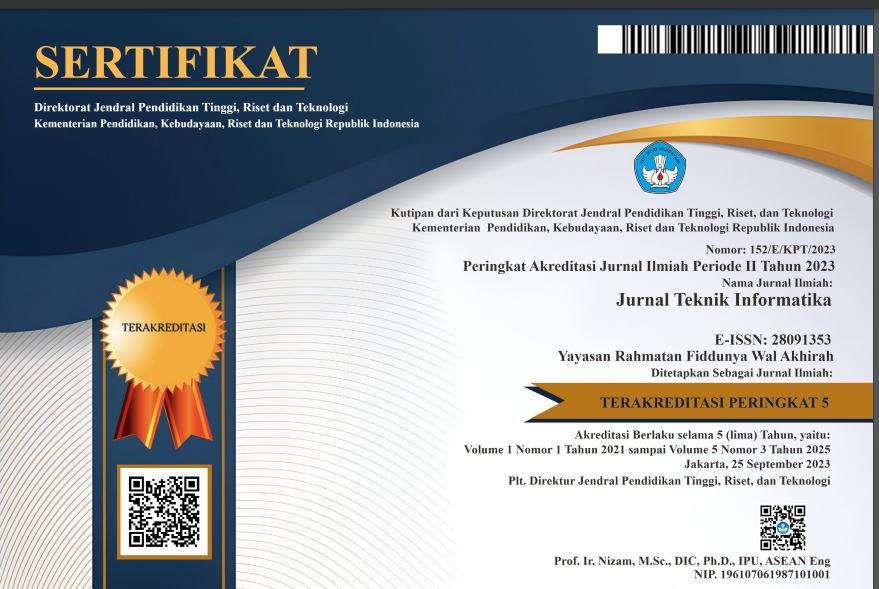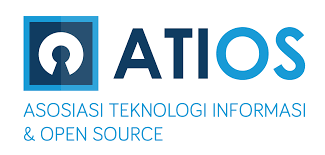Analisis Sentimen Berita terhadap Bitcoin dengan Metode Klasifikasi K-Nearest Neighbor
Keywords:
analisis sentiment, knn, cryptocurrency, bitcoinAbstract
Globalisasi telah mempengaruhi berbagai aspek kehidupan, terutama dalam kemajuan teknologi informasi dan cryptocurrency sebagai inovasi dalam teknologi finansial. Cryptocurrency seperti Bitcoin berfungsi sebagai media pertukaran dan penyimpan nilai, meski belum diakui sebagai alat pembayaran sah. Pasar cryptocurrency berkembang pesat, dengan lebih dari 10.000 aset crypto beredar di seluruh dunia. Jumlah pengguna meningkat signifikan dari 18 juta pada 2017 menjadi 516 juta pada 2023. Bitcoin mendominasi dengan pangsa pasar 60,14%, menegaskan posisinya sebagai pionir dan mencerminkan minat tinggi dari investor serta masyarakat. Penelitian ini juga mengkaji pergerakan harga Bitcoin melalui analisis sentimen menggunakan metode klasifikasi k-nearest neighbor (KNN). Hasil penelitian ini memberikan wawasan mendalam mengenai dinamika pasar mata uang kripto. Metode KNN mencapai rata-rata akurasi 74,40%, menunjukkan efektivitas pengklasifikasian menggunakan metode ini.
Downloads
References
A. Wijayanto, I. Riadi, Y. Prayudi, and T. Sudinugraha, “Network Forensics Against Address Resolution Protocol Spoofing Attacks Using Trigger , Acquire , Analysis , Report , Action Method,” Regist. J. Ilm. Teknol. Sist. Inf., vol. 8, no. 2, pp. 156–169, 2022, [Online]. Available: http://www.journal.unipdu.ac.id/index.php/register/article/view/2953/1497
S. Alam, M. Jamil, and A. Syamsir, “Digital Currency in Indonesia (Prospects and Challenges in Inclusive Financial Reviews),” J. Ad’ministrare, vol. 9, no. 2, p. 515, 2022, doi: 10.26858/ja.v9i2.39498.
R. Iyer, “New Evidence on Spillovers Between Crypto Assets and Financial Markets,” IMF Work. Pap., vol. 2023, no. 213, p. 1, 2023, doi: 10.5089/9798400256622.001.
R. Shewale, “blockchain statistics,” demandsage, 2024.
O. Sattarov, H. S. Jeon, R. Oh, and J. D. Lee, “Forecasting bitcoin price fluctuation by twitter sentiment analysis,” 2020 Int. Conf. Inf. Sci. Commun. Technol. ICISCT 2020, vol. 02, no. 1, pp. 1–12, 2020, doi: 10.1109/ICISCT50599.2020.9351527.
X. Xu, B. Zhang, W. Lv, and Weiwei, “Dynamic Crypto Currency Transaction Index Modelling Using Blockchain and Community Detection Method,” in 2021 3rd International Conference on Intelligent Control, Measurement and Signal Processing and Intelligent Oil Field (ICMSP), 2021, pp. 234–238. doi: 10.1109/ICMSP53480.2021.9513352.
L. Liestyowati, E. Sudarmanto, H. Ramadhani, S. Rijal, and T. W. Nurdiani, “Tren Investasi Aset Digital: Studi tentang Perilaku Investor Muda terhadap Cryptocurrency di Tengah Perubahan Pasar Keuangan di Kota Bandung,” J. Akunt. Dan Keuang. West Sci., vol. 2, no. 03, pp. 142–149, 2023, doi: 10.58812/jakws.v2i03.639.
F. Kjaerland, M. Meland, A. Oust, and V. Øyen, “How can Bitcoin Price Fluctuations be Explained?,” Int. J. Econ. Financ. Issues, vol. 8, no. 3, pp. 323–332, 2018.
R. Azhar, A. Surahman, and C. Juliane, “Analisis Sentimen Terhadap Cryptocurrency Berbasis Python TextBlob Menggunakan Algoritma Naïve Bayes,” J. Sains Komput. Inform. (J-SAKTI, vol. 6, no. 1, pp. 267–281, 2022.
E. T. Yolanda, L. Junaedi, and A. Bimo Gumelar, “Analisis Sentimen Pergerakan Harga Mata Uang Kripto (Cryptocurrency) Menggunakan TextBlob-NLTK (Natural Language Toolkit),” Jlk, vol. 5, no. 2, pp. 44–50, 2022.
V. R. Prasetyo, H. Lazuardi, A. A. Mulyono, and C. Lauw, “Penerapan Aplikasi RapidMiner Untuk Prediksi Nilai Tukar Rupiah Terhadap US Dollar Dengan Metode Linear Regression,” J. Nas. Teknol. dan Sist. Inf., vol. 7, no. 1, pp. 8–17, 2021, doi: 10.25077/teknosi.v7i1.2021.8-17.
A. O. Indarso, H. N. Irmanda, and R. Astriratma, “Sentiment Analysis of Cryptocurrency Exchange Application on Twitter Using Naïve Bayes Classifier Method,” Telemat. J. Inform. dan Teknol. Inf., vol. 20, no. 1, p. 15, 2023, doi: 10.31315/telematika.v20i1.9044.
G. I. Mumtazah and Y. T. Permadhy, “ANALISIS KINERJA REKSA DANA SAHAM DENGAN METODE SHARPE, TREYNOR, DAN JENSEN SELAMA MASA PANDEMI,” J. Ris. Manaj. Sains Indones., vol. 13, no. 1, pp. 53–75, 2022, doi: http://doi.org/10.21009/JRMSI.
W. M. Al-rahmi, N. Yahaya, M. M. Alamri, and N. Ali, “A Model of Factors Affecting Cyber Bullying Behaviors among University Students,” IEEE Access, vol. PP, no. November, p. 1, 2018, doi: 10.1109/ACCESS.2018.2881292.
Yoannes Romando, R. Sulistyowati, and I. S. Wibisono, “Identifikasi Komentar Negatif Berbahasa Indonesia Pada Instagram Dengan K-Means,” Multimatrix, vol. II, no. 1, pp. 6–8, 2019.
M. Andriansyah et al., “Cyberbullying comment classification on Indonesian Selebgram using support vector machine method,” Proc. 2nd Int. Conf. Informatics Comput. ICIC 2017, vol. 2018-Janua, pp. 1–5, 2018, doi: 10.1109/IAC.2017.8280617.
F. Guo, X. Zhao, B. Zou, and Y. Liang, “Automatic retinal image registration using blood vessel segmentation and SIFT feature,” Int. J. Pattern …, 2017, doi: 10.1142/S0218001417570063.
I. Riadi, Sunardi, and P. Widiandana, “Cyberbullying Detection on Instant Messaging Services Using Rocchio and Digital Forensics Research Workshop Framework,” J. Eng. Sci. Technol., vol. 17, no. 2, pp. 1408–1421, 2022.
P. Widiandana and I. Riadi, “ANALISIS INVESTIGASI FORENSIK CYBERBULLYING PADA WHATSAPP MESSENGER MENGGUNAKAN METODE NATIONAL INSTITUTE of STANDARDS and TECHNOLOGY ( NIST ),” pp. 488–493, 2019.
RSA, “2016: Current State of Cybercrime,” p. 7, 2016.
H. S. Christopher D. Manning, Prabhakar Raghavan, Introduction to Modern Information Retrieval. 2009.
I. Ruthven and M. Lalmas, “A survey on the use of relevance feedback for information access systems,” Knowl. Eng. Rev., vol. 18, no. 2, pp. 95–145, 2003, doi: 10.1017/S0269888903000638.
S. K. Sahu, S. Sarangi, and S. K. Jena, “A detail analysis on intrusion detection datasets,” Souvenir 2014 IEEE Int. Adv. Comput. Conf. IACC 2014, pp. 1348–1353, 2014, doi: 10.1109/IAdCC.2014.6779523.
E. W. Selberg, “Information Retrieval Advances using Relevance Feedback,” UW Dept CSE Gen. Exam, 1997.
P. Yugianus, H. S. Dachlan, and R. N. Hasanah, “Pengembangan Sistem Penelusuran Katalog Perpustakaan Dengan Metode Rocchio Relevance Feedback,” J. EECCIS, vol. 7, no. 1, pp. 47–52, 2013.
M. Y. R. Rangkuti, M. V. Alfansyuri, and W. Gunawan, “Penerapan Algoritma K-Nearest Neighbor (Knn) Dalam Memprediksi Dan Menghitung Tingkat Akurasi Data Cuaca Di Indonesia,” Hexag. J. Tek. dan Sains, vol. 2, no. 2, pp. 11–16, 2021, doi: 10.36761/hexagon.v2i2.1082.
Downloads
Published
Issue
Section
License
Copyright (c) 2024 JEKIN - Jurnal Teknik Informatika

This work is licensed under a Creative Commons Attribution-ShareAlike 4.0 International License.
JEKIN-Journal of Informatics Engineering provides open access to anyone, ensuring that the information and findings in the article are useful to everyone. This journal article's entire contents can be accessed and downloaded for free. In accordance with the Creative Commons Attribution-ShareAlike 4.0 International License.

JEKIN-Journal of Informatics Engineering is licensed under a Creative Commons Attribution-ShareAlike 4.0














